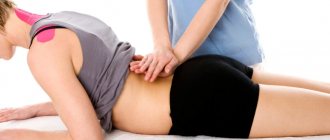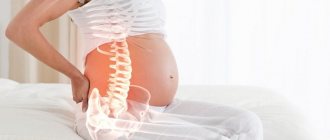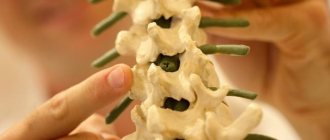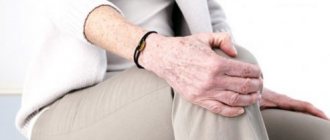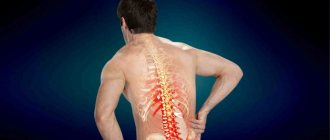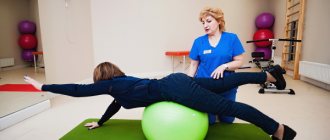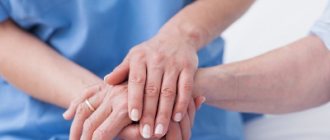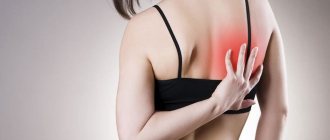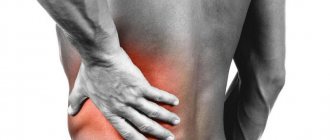“The right side of the back hurts” - these are the complaints that people most often come to the doctor with, but this is such an abstract and vague concept, because this symptom can indicate a large number of different pathologies.
In both women and men, the right side behind the back can hurt due to pathologies of the spine, problems with the kidneys or intestines, as well as abnormalities in the genitourinary system. That is why you need the help of an experienced specialist, because only he will make the correct diagnosis and prescribe the correct treatment.
When does the pain appear?
Pain in the right side, felt in the back area, is a symptom that can appear with the following diseases.
- Muscles of the back or spine
- Respiratory system diseases:
- Pleurisy (“dry”);
- Pneumonia;
- Pneumothorax;
- Bronchial and lung cancer.
- Digestive system diseases:
- Intestinal colic;
- Acute cholecystitis
- Appendicitis.
- Diseases of the urinary system:
- Retroperitoneal hematoma;
- Hydronephrosis;
- Glomerulonephritis;
- Pyelonephritis;
- Kidney abscess;
- Renal colic (kidney stones).
- Lesions of the spine, spinal cord:
- Osteochondrosis;
- Spondylosis;
- Intervertebral hernia.
The list of possible diseases that cause pain in the right side, localized in the back, is quite long. You should definitely pay attention to the nature of the pain and the accompanying symptoms.
If the pain spreads along the hypochondrium from back to front
The most common cause is kidney and musculoskeletal diseases.
Pyelonephritis
Inflammation in the renal pelvis is caused by infection that comes with blood from chronic foci (boils, tonsils, maxillary sinus, osteomyelitis, internal genital organs) and from the urinary tract. The disease can be unilateral or bilateral, acute and chronic. In the chronic version of the course, ulcers form in the kidney tissues.
..
In the acute form, symptoms quickly increase: the temperature rises to 39 degrees, the patient has chills, intense sweating, nausea, headache, and severe weakness. Then, with a right-sided process, pain appears in the right hypochondrium from the back.
Chronic pyelonephritis leads to scarring of part of the parenchyma
At first it is local, then spreads along the hypochondrium anteriorly into the abdomen. When both kidneys become inflamed, they become encircling. The patient is bothered by pain when urinating and frequent urges.
Purulent complications develop in the form of small multiple pustules (apostematous pyelonephritis) or carbuncles, boils. Pyelonephritis is associated with kidney stones, which provide favorable conditions for infection of the parenchyma.
The diagnosis is made on the basis of urine analysis (leukocytes, pus, mucus, red blood cells), the Nechiporenko test, and confirmation of the presence of infection by culture. Hardware techniques (ultrasound, excretory urography). If necessary, cystoscopy and angiography of the renal vessels are performed. A consultation with a gynecologist is required for women; in men, a urologist examines the prostate.
Treatment includes diet, antibacterial agents, anti-inflammatory and diuretic herbs. If there is no result and there is a threat of sepsis, the abscess in the kidney is surgically removed along with the affected area of the organ. If the kidney is not viable, then a nephrectomy is performed.
Urolithiasis disease
It is formed due to the precipitation of salts, their gluing into insoluble concretions (stones). The cause is impaired metabolism, local chronic inflammatory process, conditions accompanied by significant loss of fluid (diarrhea, vomiting, lack of sufficient drinking in the heat, uncontrolled use of diuretics).
The most commonly found stones are oxalate, phosphate, and urate crystals.
The main symptom of the disease is an attack of renal colic: acute pain in the lower back and side with radiation to the hypochondrium in front, down the abdomen, groin and external genitalia. It is caused by a stone blocking the urine outflow tract and spastic contraction of the muscular layer of the ureter.
It is often provoked by shaking in transport, running or jumping in the gym, or heavy physical activity. At the height of pain, patients are agitated, vomiting, headache, bloating, and constipation are possible. The attack lasts from several minutes to 5–6 hours. Once completed, fresh blood is released in the urine.
During the interictal period, the patient feels dull pain in the lower back
For diagnosis, in addition to urine analysis, contrast methods of x-ray examination of the urinary tract, ultrasound, and cystoscopy are required. The treatment uses a diet depending on the type of salt sediment in the urine, diuretic herbs, uroantiseptics, vitamins to restore proper metabolism, and special mineral water. Lack of effect and frequent attacks are indications for surgical stone removal.
[node:field_field_doprekl]
Bruises and fractures of ribs
With a closed injury to the right side of the chest and lumbar region, the ribs are most often affected. The ribs account for up to 15% of all fractures. An important feature is the possibility of injury to internal organs.
The neurovascular bundle that supplies the muscles is necessarily damaged. Most often, ribs from pairs V to VIII are broken. From IX and below, fractures are rare, since these ribs have sufficient mobility.
Pain is one of the main signs of a fracture. It is maximum in the area of injury, radiating anteriorly along the intercostal space. Typically worsens when breathing, moving, coughing. Decreases in a sitting position.
At the same time, the victim experiences:
- shallow rapid breathing;
- lag of the injured part of the chest;
- bruising and swelling at the fracture site.
With several fragments, the doctor feels a crunching sound upon palpation, the sound of bones rubbing. In case of complications develop:
- subcutaneous emphysema - due to damage to the lung tissue by the rib, air escapes under the skin;
- hemoptysis - complements the picture of a damaged lung;
- pneumothorax - drawing an air stream into the pleural cavity, which can displace the lung into the mediastinum and cause cardiac arrest, pleuropulmonary shock;
- hemothorax is an accumulation of blood in the pleural cavity.
- inflammation of the lung.
Diagnosis begins with an examination, the doctor pays attention to bruising, the patient’s inability to take a deep breath, pain and local signs on palpation
In doubtful cases, chest compression tests and body tilt in the healthy direction are used. When a rib is fractured, the pain increases sharply. X-ray confirms the presence of bone fragments. Treatment is reduced to pain relief using a blockade with the introduction of an alcohol solution of Procaine, applying a circular bandage to create immobility.
Retroperitoneal hematoma
It is formed by the accumulation of blood as a result of rupture of blood vessels, damage to organs, fractures of the pelvic bones, ribs, and spine. A possible cause is a strong blow from an accident or a fall from a height. A hematoma can hold up to 3 liters of blood. In the area of the right hypochondrium, parenchymal organs (liver, kidneys, pancreas) are susceptible to injury.
Depending on the depth and nature of the damage to the organ, ruptures are distinguished:
- superficial - their depth is up to 3 cm;
- deep - penetrate deeper than 3 cm;
- central - localized in the area of the organ’s gate;
- subcapsular - damage is superficial or central in nature with the capsule preserved;
- separation and crushing of part or the entire organ.
The hollow organs of the right hypochondrium (gall bladder, duodenum) are damaged during trauma in the form of: tearing of the membrane, complete rupture, separation or crushing. The nature of the pain is determined by the severity of the injury.
Patients complain of sharp pain in the abdomen, under the ribs, along the lateral surface, in the lower back; when moving, it becomes unbearable, dizziness, weakness due to blood loss; in a state of shock, intestinal paresis with cessation of peristalsis is possible.
With a small hematoma, the symptoms are scanty: dull or aching pain that is caused by compression of surrounding organs. In diagnosis, the doctor’s experience, ability to palpate the abdomen, and identify associated signs of pain are important. Ultrasound and magnetic resonance imaging help.
Treatment is necessary as early as possible. Shock is combated with therapeutic agents and hemostatic drugs are administered. In cases of severe injury, surgery is necessary to stop the bleeding.
[node:field_field_doprekl2]
Muscles of the back or spine
According to the National Institute of Neurological Disorders (NINDS), 80% of adults experience low back pain on a regular basis. Most of this pain is caused by mechanical problems such as:
- Excessive stretching or tearing of a ligament due to improper lifting.
- Degeneration of the shock-absorbing spinal disc due to aging or normal wear and tear.
- Muscle tension due to poor posture.
Treatment depends on the cause and severity of your condition. Your doctor may initially recommend more conservative options, such as physical therapy or medications to reduce inflammation. If conservative treatments don't help or if your condition is severe, your doctor may recommend surgery. [1]
Therapeutic measures
As mentioned above, at the first signs of pain on the right side of the back, you should seek help from a doctor, undergo a set of diagnostic measures, and receive appropriate treatment. A set of therapeutic measures includes taking painkillers to eliminate discomfort. The further treatment regimen depends on the diagnosis.
The patient can alleviate his condition at home by following these recommendations:
- the patient should be at complete rest;
- if there is pain, use analgesics;
- limit the patient from irritating factors.
Before performing such procedures, it is important to clarify the cause of back pain.
It is worth remembering that back pain can occur not only due to problems with the spine, but also due to pathologies of internal organs, which can be much more serious. At home, it is impossible to determine the cause of the disease, so a meeting with a doctor cannot be avoided, and you should not delay this process. The sooner a person consults a doctor, the faster he will regain his health.
Respiratory system diseases
Pain in the right side, manifested from the back, is one of the characteristic signs of pathologies of the respiratory system.
- Inflammation of the pleura (pleurisy) can be exudative and dry, in both cases it can manifest itself with sharp pain when breathing. In the purulent form, severe pain on the right side is accompanied by poor breathing on the affected side. The dry form makes itself known by cutting pain attacks, activated by movement and coughing.
Pleurisy and other pleural disorders are treated with: [2]
- Symptom relief (ibuprofen, cough syrups).
- Removing fluid, air, or blood from the pleural space (if large amounts are present).
- Treatment of the underlying condition.
- Pneumonia (right-sided pneumonia) is accompanied by symptoms such as fever, wheezing in the lungs, and cough. The intensity of pain varies.
- Spontaneous pneumothorax causes acute, sudden pain radiating to the scapula. This is a condition in which air enters the lungs (pleural space). Typically, the doctor will deflate the air using a needle or tube; this procedure does not require general anesthesia.
- Lung cancer is a disease characterized by nagging pain localized in the back on the right; seizure of the shoulder blade and right shoulder is also possible. The syndrome becomes more active as the tumor grows, during movement, coughing, and breathing.
Specialist help and diagnostics
If a person is bothered by pain in the side from the back, then first of all it is worth visiting a therapist, who, after a full examination, will send the patient to a more specialized specialist. Namely:
- to diagnose spinal diseases, it is worth visiting a neurologist, orthopedist and traumatologist;
- if there are deviations in the functioning of the genitourinary system, then it is worth visiting a urologist;
- a nephrologist specializes in kidney pathologies;
- representatives of the fair sex are referred to a gynecologist.
To determine the exact cause of painful urges, it is worth going through a series of diagnostic procedures and taking several tests. The list of mandatory ones includes:
- clinical urine analysis;
- clinical and biochemical blood test;
- X-ray examination;
- ultrasound diagnostics of the pelvic organs;
- urine according to Nechiporenko;
- Magnetic resonance imaging;
- CT scan.
Depending on the intended diagnosis, something may be excluded from this list, and something may be added.
No ads 3
Digestive system diseases
Pain that is concentrated in the back right side may also indicate problems related to the digestive system.
- Acute cholecystitis is a disease in which pain is concentrated in the right intercostal space and can radiate to the shoulder girdle, scapula, and right shoulder. In some cases, a burning sensation in the lower back is also present. The duration of the attack can range from several days to several hours. Additional symptoms are fever, bouts of vomiting.
- Intestinal colic can also cause pain in this area. You can eliminate it with the help of No-Shpa; it often disappears on its own.
- Acute appendicitis can also cause pain in the right side behind. This rare symptom appears if the appendicular process is localized behind the cecum, enlarged in size, and swollen.
Traditional treatment is to remove the appendix (appendectomy). In some cases, it can be treated with antibiotics alone, meaning you may not need surgery. In one such study, nearly 75% of people who received antibiotics during appendicitis did not require an appendectomy. [3]
When emergency help is needed
Advertising:
It is necessary to consult a doctor if the pain in the subcostal area is quite severe and does not disappear after 30-40 minutes. A person needs to be wary if discomfort does not decrease while taking antispasmodics. An ambulance should be called when there is a rapid increase in body temperature, persistent vomiting or diarrhea. Immediate medical intervention will be needed if at the same time the patient feels severe dizziness, vision problems, or loses consciousness.
If you have at least one of these symptoms, you need to call a doctor at home, and while he is driving, lie down on the sofa and take the position in which the pain is felt the least. In such cases, it is impossible to warm up or apply ice, as well as take strong painkillers. You should also not use folk remedies, because until a diagnosis has been established, any measures can be harmful. If the symptoms described above are absent, but discomfort and pain periodically return, you need to make an appointment with a doctor as soon as possible. The sooner the cause of the problem is determined, the faster it can be eliminated.
Diseases of the urinary system
Many kidney diseases can cause pain in the back of the right side.
- Glomerulonephritis, hydronephrosis, kidney abscess and other pathologies are marked by aching, drawing, dull and sharp pain. The pain increases if you put pressure on the lumbar area.
- Stones in the kidneys. Renal colic (obstruction of the ureter by a stone) causes acute pain in the lumbar region, nausea, vomiting, and hematuria. Also, this type of pain may indicate renal artery thrombosis.
- Despite the fact that kidney stones account for about 30-40% of all causes of hospitalization in urological departments of hospitals, pain in the kidneys can also be caused by infection (pyelonephritis). The most common cause of kidney infections is bacteria (E. coli) that enter the urinary tract through the urethra. [4]
We are looking for the culprit
Making a diagnosis of pain above the lower back on the right in men and women requires a detailed examination of the patient: it may signal problems with the urinary, digestive or (in women) reproductive systems. They meet often. Therefore, it is necessary to begin treatment with a visit to the therapist.
The results of the examination will help the doctor with a high probability to exclude these conditions, but now it is customary to prove diagnoses. Therefore, your doctor will order blood and urine tests, and possibly an abdominal ultrasound, to look for conditions that cannot be seen in other ways. Based on the results of the examination, the doctor will prescribe medications. They will alleviate a person’s condition without harming him. But it’s too early to talk about serious treatment.
When internal diseases are excluded, we begin to diagnose back diseases. To do this, the patient is prescribed an x-ray of the lumbar region in two projections and an appointment with a neurologist. He decides whether magnetic resonance imaging (MRI) is necessary or whether there is enough data to begin treatment. An option is possible when therapy begins with methods that are harmless to the patient, regardless of the MRI results. It is often impossible to make an appointment for this procedure in the next few days, and it is impossible to force the patient to suffer while his turn approaches.
Problems of the spinal cord, spine
Intervertebral hernia, osteochondrosis, spondylosis, pinched nerve roots - all these problems can cause sharp pain localized on the right side of the back. In order not to confuse spinal pathology with other diseases, it is worth studying other signs. A feeling of stiffness appears in the back, a pain attack increases with movement, radiating to the chest, limbs, and groin area. Numbness and “pins and needles” may also occur.
Severe pain is possible with a fracture of the scapula or ribs on the right. It is activated by coughing, deep breathing, and movements.
Features of the “geography” of the right hypochondrium zone
The hypochondrium area is well protected by the dense muscles of the abdomen and back, the rib cage, the layers of the peritoneum, and the diaphragm. Important parenchymal organs fit tightly together here.
The skeleton of the chest has special movable lower two pairs - the XI and XII ribs. They do not “weave” into the costal arch on the right, but end with free ends in the muscles of the peritoneum.
The kidney is located retroperitoneally at the level from the III lumbar to the XI thoracic vertebra. The very last rib intersects along the posterior surface at the border of the upper and middle third. It is supported by ligaments, a special muscle bed and intra-abdominal pressure created by contraction of the abdominal press and diaphragm.
Further, the liver is adjacent to the anterior surface at the level of the upper 2/3, and the bend of the colon is located to the lower 1/3. The central zone is in contact with the duodenum. On the surface of the liver there are anatomical pits where the right pole of the kidney, the head of the pancreas, the flexure of the duodenum, and the gall bladder are compactly placed.
The leaves of the peritoneum surround them completely or partially. Powerful ligaments attach to the diaphragm. We will consider possible causes of pain depending on the location of the source and taking into account the nature of the spread.
How to calculate a “sick organ”?
Often, people experiencing pain concentrated in the back right side have no idea which specialist to contact or which organ the problem is associated with. Of course, only a specialist can make an accurate diagnosis after completing a full examination.
However, the location, intensity and nature of pain attacks can tell us something:
- Right under the shoulder blade. Perhaps the problem is neurological in nature and is the result of a pinched nerve. You can also suspect lung diseases: pneumonia, pleurisy, lung cancer.
- Under the ribs. The liver and pancreas are located here, and the gallbladder is located. Pathologies of any of these organs can be a source of pain. For prolonged pain, the liver is checked first.
- Right in the central part. Most likely, the problem is related to kidney disease.
- Lower back right. Painful attacks may indicate pathologies and injuries of the spine, hernias. Disruptions in the urinary system are also likely. In the latter situation, the pain does not subside in any position.
Back pain on the right side can also bother a person in the morning. Possible problems that cause pain after waking up are an incorrect mattress, muscle dystrophy.
Types and nature of pain
When interviewing a patient, the doctor always asks about the intensity of pain, its nature and location. This is very important, as it will help in further diagnosis and help determine why the right side of the back hurts. The pain may be:
Pain in the lumbar region
- cutting;
- piercing;
- dull;
- acute;
- aching;
- burning;
- pulling.
Depending on the location: below the lumbar region, above the lumbar region. In addition, the pain can be on the right side, or radiate to nearby organs and tissues, and also occur periodically, or accompany the patient constantly. A stabbing pain occurs during movement. Most often, pain is observed against the background of acute pancreatitis; the patient has a stabbing sensation from the back to the right, even when stationary.
If your back hurts, this may be a sign of a serious illness. Over time, the pain may turn into aching, this is a signal that you need to see a doctor.
Burning, sharp and cutting pains develop against the background of spinal injuries, due to damage to the back muscles, as well as due to abnormalities in the functioning of internal organs. When a person has pinched vertebrae, rheumatism, radiculitis, and neurological disorders, the pain will be shooting in nature. Most often, painful urges are localized on the lower right, and in the lumbar region.
No ads 2
Damage to the digestive tract
With chronic inflammation in the liver and gall bladder, dull, aching pain occurs above the lower back in the right hypochondrium. Unpleasant sensations persist for weeks and months, years. To restore their full functionality, attention should be paid to the entire digestive tract. If parasites are diagnosed in the liver, then you need to take antihelminthic drugs.
Comprehensive treatment of parasitic disease:
- adherence to the “Table No. 5” diet;
- choleretic agent;
- enzyme preparation;
- antimicrobial agent;
- anthelmintic drug;
- enterosorbent to cleanse the intestines of toxins;
- probiotics to restore intestinal microflora;
- collection of herbs chamomile, rose hips, corn silk.
Cholecystitis is accompanied by pain in the abdomen on the right under the ribs, which radiates to the right shoulder blade and shoulder. Alcohol, fried and fatty foods provoke an attack. Pain from the pancreas is rarely felt from the back. However, this organ is interconnected with the stomach and gall bladder. The pancreas becomes inflamed when the acidity of the gastric juice increases and the bile duct is blocked. A severe pain attack occurs.
In the case of pathologies of the gallbladder, the pain is localized above the waist - in the right hypochondrium, and radiates to the right shoulder blade. It is recommended to follow a diet and avoid alcohol intake. To relieve spasms, take the drugs Buscopan and No-shpa.
Doctors usually suggest removal of the gallbladder to a patient with acute cholecystitis, as there is a high risk of developing peritonitis. A modern, low-traumatic method is endoscopic surgery. No incision is made, but the gallbladder is removed through small punctures.
Classification of pain syndromes
To make the correct diagnosis and select the appropriate treatment, it is necessary to take into account the duration, intensity and nature of the pain. Depending on this, all pain syndromes can be divided into several groups:
- Spasmodic. This type of pain syndrome is usually aching or dull in nature and increases in intensity with exercise and movement. Typically, spasmodic syndrome is characteristic of muscle diseases. In addition, such pain in the side may be accompanied by a headache that radiates to different parts of the back.
- Projection. The cause of such pain is most often diseases associated with neurology. In this case, the pain is very pronounced, spreads over the entire back or over a separate part of it, but can be concentrated in a very small area. The nature of the pain is throbbing. The intensity may increase with movements and turns, as well as with increasing load.
- Reflected. As a rule, such pain occurs in the presence of injuries or pathological changes in internal organs. It usually has a pulling character, does not appear clearly and may even disappear for a while. When probing with your fingers, the reflected pain intensifies, as well as with increasing loads on the spine.
- Koreshkovy. Such pain, when the human body is at rest, may disappear or change its intensity. Typically, discomfort and pain in this case at rest become dull and aching, and with movement and stress they intensify and take on a pulsating or shooting character. Such pain can radiate to different areas of the back, and also radiate to the legs. They are often symptoms of spinal diseases and neurological problems.
- Local. Such pain usually does not stop for a second. It intensifies with any movement. And the place where the hearth is located can be accurately determined. With local syndrome, a person usually loses his mobility and cannot lead his usual lifestyle.
Preventive measures for radiating pain in the back and right side
Experts say that it is easier to prevent the occurrence of back pain radiating to the right side than to treat diseases that have already arisen.
Many diseases, the symptoms of which are pain in this area, for example, osteochondrosis, cannot be cured completely, but can progress quickly if the necessary measures are not taken in time.
Among the main recommendations given by doctors, the following actions will be effective in preventing the occurrence of back pain:
- you need to sleep only on a high-quality mattress and orthopedic pillow;
- you should wear comfortable shoes that will help evenly distribute the load on the musculoskeletal system;
- use special pillows and bolsters during long trips and flights, or while sitting at the computer;
- take regular breaks during sedentary work;
- choose the optimal physical activity;
- avoid heavy lifting, physical and mental fatigue;
- reduce stress;
- eat a balanced diet, if necessary, take vitamin-mineral complexes and other medications as recommended by your doctor;
- prevent hypothermia;
- do not make sudden movements that could lead to injury;
- stop smoking, drinking alcohol and other bad habits.
In addition, it is very important not to miss preventive examinations from specialists. This will help to promptly treat all emerging pathological processes and prevent the development of complications that can lead to pain and other manifestations.
As you can see, pain in the back and right side can appear for various reasons. And only a specialist is able to determine the disease that provoked their occurrence. The sooner suitable treatment is selected and started, the higher the chance of avoiding complications. And prevention methods and a healthy lifestyle will help you maintain good health for many years, regardless of your age.
Treatment: how to get rid of pain
Pain on the right side of the back above the lower back will go away after proper therapy. When stones are detected in the kidneys, doctors strive to break the formations or remove them surgically. But first, the cause is always identified, and only then a set of medications is prescribed.
When the back hurts on the right above the lower back in men, this can signal nervous tension, a pinched nerve under load. This requires physical therapy, various exercises, and in critical situations, surgery. Disorders in the spine are different, sometimes they require urgent treatment.
For osteochondrosis, drugs are prescribed: analgesics, antispasmodics, various vasodilators. Physiotherapy helps - the patient is offered different types of massage. They also give injections of drugs that increase muscle tone. Osteochondrosis may also require surgery.
